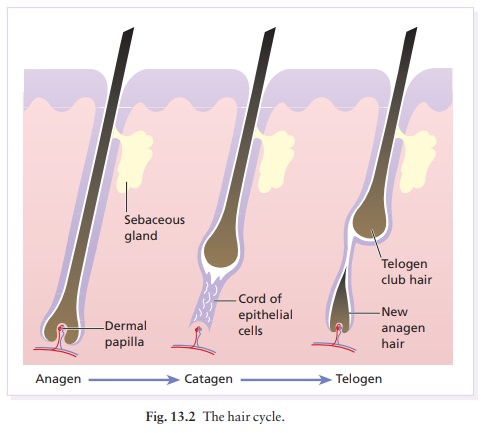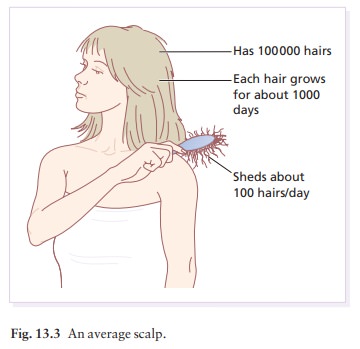Chapter: Clinical Dermatology: Regional dermatology
The hair cycle

The hair cycle
Each
follicle passes, independently of its neighbours, through regular cycles of
growth and shedding. There are three phases of follicular activity (Fig. 13.2).
1 Anagen. The active phase of hair production.
2 Catagen. A short phase of conversion from
active growth to the resting phase. Growth stops, and the end of the hair
becomes club-shaped.
3 Telogen. A resting phase at the end of which
the club hair is shed.

The duration of each of these stages varies from region to region. On the scalp (Fig. 13.3), said to contain an average of 100 000 hairs, anagen lasts for up to 5 years, catagen for about 2 weeks, and telogen for about 3 months. As many as 100 hairs may be shed from the normal scalp every day as a normal consequence of cycling. The proportion of hairs in the growing and resting stages can be estimated by looking at plucked hairs (a trichogram).

On the scalp, about 85% are normally in anagen
and 15% in the telogen phase. The length of hair is determined by the duration
of anagen; e.g. the hairs of the eyebrows have shorter cycles than those of the
scalp.
Each
hair follicle goes through its growth cycles out of phase with its neighbours,
so there is no moulting period. However, if many pass into the resting phase (telogen) at the same time, then a
correspondingly large number will be shed 2–3 months later (see Telogen
effluvium, below).
There
are important racial differences in hair. Asians tend to have straight hair,
Negroids woolly hair and Europeans wavy hair. These differences are associated
with different cross-sectional shapes (round, flattened, etc.). Mongoloids have
less facial and body hair than Mediterranean people who also have more hair
than northern Europeans.
Related Topics